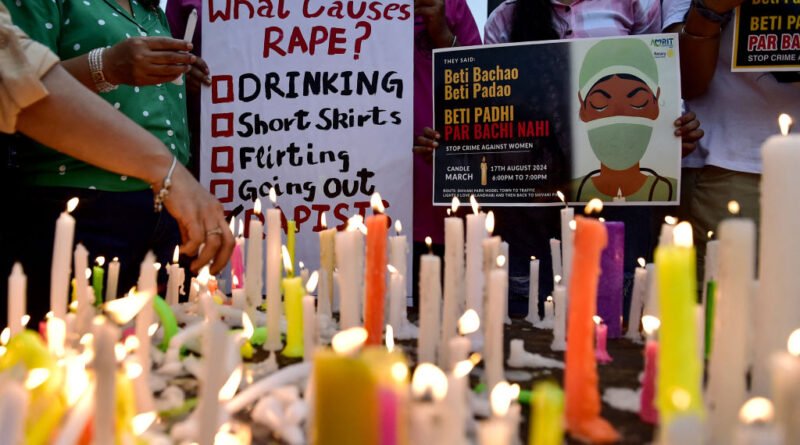Experts: Increased Porn Accessibility Linked to Surge in Sexual Violence in India
A brutal rape and murder in Kolkata sheds light on a hidden industry that is easily accessible on smartphones.
News Analysis
DELHI—The tragic rape and brutal murder of a 31-year-old trainee doctor on Aug. 9 in India’s eastern city of Kolkata—reportedly by a hospital volunteer—continues to dominate news headlines and public discussions in the nation.
An analysis conducted by India’s Central Bureau of Investigation revealed that the main suspect in the case was severely addicted to pornography, characterized as a “sexual pervert” with “animal instincts,” according to Indian news service PTI.
The incident has led to massive protests by doctors across the country and solidarity protests in countries like Australia, Bangladesh, and Pakistan. In addition to a widespread demand for justice for the victim, it has once again brought attention to the escalating sexual violence against women in India.
Despite reforms to India’s criminal justice system following a highly publicized gang rape in 2012, the annual number of reported rapes in India has remained around 30,000.
In 2018, on average, a rape was reported every 15 minutes in the country, according to a government report.
In 2022, the latest year for which data is available, there were more than 31,000 reported rapes, a 20 percent increase from the previous year. Since many cases go unreported, it is thought that the actual numbers are much higher.
Possible factors behind the rise in sexual violence have been widely discussed, with commentators pointing to Indian societal and family structure, its court system, law enforcement, and other factors.
According to one expert, the Kolkata case raises the alarm about another issue, namely the surging consumption of pornography in India and its effect on behavior, relationships, and sexual violence, as well as wider social misconduct.
‘The Most Violent Drug on Earth’
Texas-based Jaco Booyens has been crusading against sex-trafficking for more than two decades. A filmmaker and entrepreneur, Booyens is host of the “The Bottom Line” podcast and has worked with anti-trafficking agencies around the globe. The Epoch Times talked with Booyens on Aug. 22, in an attempt to understand the psychological and sociological perspective to the crisis in India.
Pornography, Booyens said, is a “drug”: a violent and speedy drug that quickly erodes a society’s social fabric. Porn affects behavior in the same way as drugs such as cocaine, heroin, and alcohol, but the latter are more widely identified and accepted as a menace, he said.
According to Booyens, if India wants to address its rape problem, it needs to recognize how pornography is undermining its families and its broader social behavior.
“The drug is external. So someone has financial problems, they get depressed, so they could drink alcohol and become an alcoholic. If you remove alcohol from them, [they] sober up,” he said. Pornography, on the other hand, is the only drug that’s “internal,” he said, making it especially malignant. “It’s the most violent drug on earth.”
Despite the increasing cases of sexual abuse in the country, addiction to pornography has yet to receive its due in the public health ecosystem of India.
Booyens said it’s important to draw a connection between the consumption of pornography and the increasing number of rapes. He described the psychological relation between the two.
“It’s a drug that never satisfies, ever. Remember, heroin, cocaine has about a four and a half, five-hour high, and people can manage to stay on a high for weeks with different drugs,” he said.
“A sexual high is 30 seconds, after 30 seconds of a sexual high, the desire for the next hit is immediate, which means the intervals in consumption [are] very short, which means the frequency of abuse is very high, which means they get de-sensitized to the images. So the images have to become more graphic, more violent.”
The human brain gets used to pornography and “normalizes” it. It then desires “a stronger drug” and reaches a point where the addicted consumer wants to act out on those desires, according to Booyens.
With pornography addiction, “normally, what happens is men will become sexually violent with their wives,” Booyens said. “When that no longer sustains [the high], they‘ll go buy sex.” And when that’s no longer enough, they’ll turn to rape, he said. Further, as the addiction progresses, the person is likely to engage in child molestation or child sex trafficking, he said.
According to numbers from a widely reported analysis by Indian NGO Child Rights and You (CRY), child rape cases in India increased by 96 percent between 2016 and 2022.
“You’re now taking sex from someone who is completely defenseless,” said Booyens. “You’re looking at a culture with one of the highest rape rates because they’ve got one of the highest pornography addiction rates.”

People hold posters during a vigil condemning the rape and murder of a trainee doctor at a government-run hospital in Kolkata, on a street in Mumbai, India, on Aug. 14, 2024. Francis Mascarenhas/Reuters
A ‘Time Bomb’
India has more than 1.08 billion smartphone users in 2024. That number is estimated to increase to 1.55 billion by 2040, while it is estimated that the Indian economy will contribute 30 percent to the global GDP by 2040. Along with the country’s rapid economic growth and increase in smartphone use, the use of porn is also estimated to grow exponentially.
Booyens digs deeper into the sociology of aspirational societies like India, warning that widespread addiction to pornography could soon be a time bomb. He explains this on the basis of two psychological factors: “need and desire.”
“The desire to be a doctor is great. The need financially, to carry a family on your shoulders, to work yourself out of a class system, etc, is a great need,” Booyens said.
Booyens’ meaning: In developing societies such as in India, “need” and “desire” are strong drivers. Today’s generation is doing better than the last: in the example of the Kolkata rape victim, her father was a poor street tailor, but she became a doctor—an achievement not just for her but for her entire family and community.
In a society like India, the need to do better, to rise out of poverty and social limitations, is coupled with a desire to excel. Need and desire drive a tremendous amount of growth in this context.
And as India’s standard of living improves, the “need and desire” for more and better opportunities is contagious, particularly in a society where the median age is only 28 years. Sixty-six percent of India’s population—808 million people—are below 35 years of age.
Adding pornography into this mix of social-psychological factors “is a time bomb,” Booyens said. “It is a matter of time before people are being exploited [in] mass numbers.”
Pornography has the potential to create massive unrest, he said, as normal human emotions, running strong in a developing society, are twisted. Focused, productive people become addicts who undercut the productivity of an emerging economy and then prey on others, creating a society of predators and traumatized victims.
“So between these two worlds of desire and need, if you introduce sexual immorality into that culture, it’s anarchy, absolute anarchy. Pornography is the entry drug to human trafficking. Pornography is the catalyst. Pornography is the secret sauce that starts chipping away at the moral fiber of a culture,” said Booyens.
“The majority of users reported loss of productivity at the workplace,” according to the study of global trends. “Users are known to develop psychiatric distress due to problematic use of
Source link





